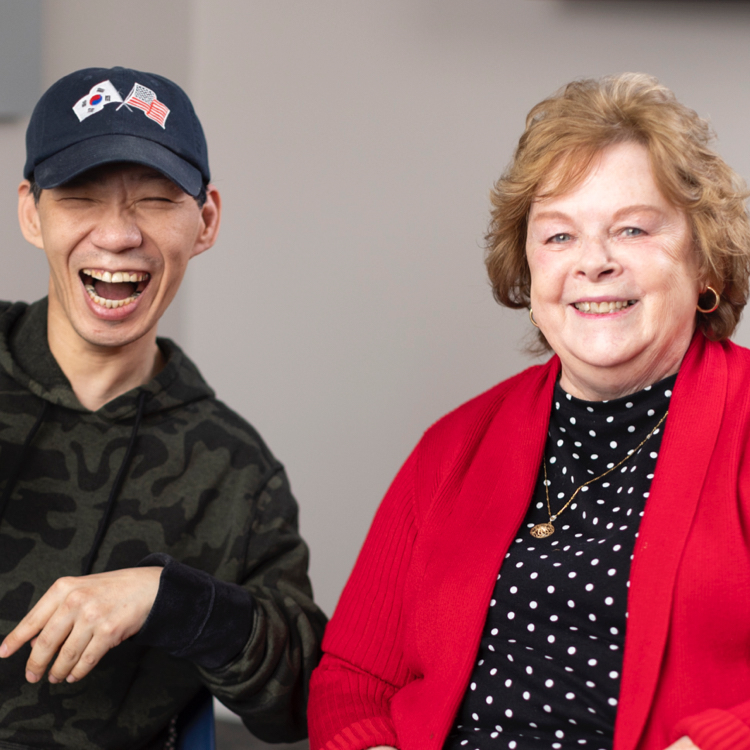Expose & Bond
Treatment for Impacted Canine Teeth
Every tooth in your mouth plays an important role in your oral health and the way your mouth functions. If a tooth is impacted, or stuck beneath the gums, it cannot erupt or function properly. The maxillary cuspids are the second most common tooth to become impacted. When a canine tooth is impacted, we help it erupt through a treatment known as expose and bond.
At Oral Surgery & Dental Implant Experts of Cincinnati, our board-certified oral surgeons work with you and your orthodontist to create a custom care plan to manage an impacted canine tooth. Dr. Robert Lucas, Dr. Garrett Seghi, and Dr. Eric Murnan perform the surgical procedure of the expose and bond treatment in the comfort of our offices in Cincinnati and Mason, OH. We also offer many anesthesia options to provide a calm, comfortable oral surgery experience. If you or your child have an impacted canine tooth, contact us to schedule a consultation with one of our oral health experts and receive a custom treatment plan.
What Is an Impacted Canine Tooth?
When a tooth is trapped beneath the gums and cannot erupt into the dental arch, it is considered to be impacted. An impacted tooth requires treatment from dental experts because these teeth are not likely to erupt on their own when their path of eruption is blocked.
It is common for a wisdom tooth or canine tooth to become impacted, although impaction can happen to any tooth. Wisdom teeth are extra teeth that develop and are not necessary for oral function. Therefore, an impacted wisdom tooth is simply extracted. Canine teeth, however, are important for maintaining a healthy bite and every effort is made to save them.
Canine teeth have the longest roots of any other human teeth and are the first teeth that touch when you bite together, which helps to guide a proper bite. They are long and sharp, and help you bite into food so you can safely chew and swallow.
An impacted canine tooth should be treated by an oral health expert so that it can function properly. If left untreated, an impacted canine may cause:
- Difficulty eating
- Damage to adjacent teeth if a partially erupted tooth pushes against nearby teeth
- Tooth decay or gum disease
- Tooth pain
- General teeth misalignment
What Causes an Impacted Tooth?
Canine teeth are the last adult teeth to develop and may become impacted due to one or more reasons, such as:
- A baby tooth or abnormal growth is blocking its path
- Dental overcrowding
- Not enough room in the dental arch
Having an impacted canine tooth treated early will increase the chances of the tooth successfully erupting and functioning. It is recommended that treatment for an impacted canine tooth begins around the age of 13 when the tooth develops. As a child’s mouth is developing, it is easier to guide the teeth and bite into their proper positions.
When an impacted tooth is left untreated, it will become more fused with the jaw bone. Once it has fused in place, the canine tooth likely cannot be treated with expose and bond. The only option left is to extract the tooth and replace it with a dental implant.
The Expose and Bond Process
First, our team will take 3D scans to assess the teeth and create a treatment plan. Treating an impacted canine tooth requires joint collaboration between your oral surgeon and your orthodontist. Your oral surgeon will surgically expose the impacted tooth and attach a bracket to it. This bracket has a gold chain attached, which is then secured to braces. Your orthodontist will use the chain to gently pull the tooth into the dental arch and align it with the other teeth.
We offer many anesthesia options and will help you select the right choice prior to any procedure to ensure your or your child’s comfort. During the procedure to expose the tooth, we will administer the chosen form of anesthesia and wait for it to take effect. Once you or your child are comfortable, your surgeon will make an incision in the gum tissue to access the tooth and bond a bracket to it. The incision is closed with sutures, and we will provide post-operative instructions that outline how to care for the surgical site. It is important to see an orthodontist within 2 weeks of having the tooth exposed and bracketed to begin pulling the tooth into alignment.
Types of Anesthesia
Learn more about the types of anesthesia and sedation options available.
Expose and Bond Treatment in Cincinnati & Mason, OH
At Oral Surgery & Dental Implant Specialists of Cincinnati, our oral surgeons work hand-in-hand with your orthodontist to help an impacted tooth erupt, function, and look aesthetically pleasing. We treat impacted canine teeth for patients of all ages at our offices in Cincinnati and Mason, OH, and invite you to schedule an appointment with us if you or your child have an impacted tooth.
Hear From Our Patients
Cincinnati’s Destination for Oral Surgery Excellence
At Oral Surgery & Dental Implant Specialists of Cincinnati, we pride ourselves on delivering exceptional patient care and clinical outcomes to the greater Cincinnati area. Contact our offices in Cincinnati or Mason, OH, to schedule a consultation and see how oral surgery can improve your smile, confidence, and health.











